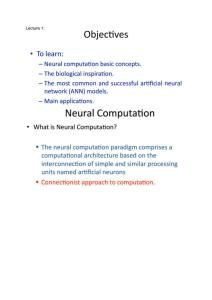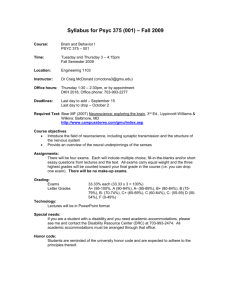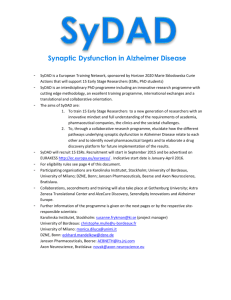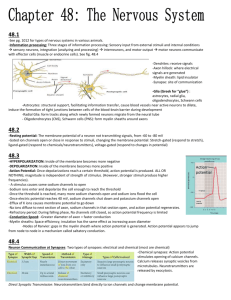The Dynamics of Learning and Memory: Lessons from Neuroscience
advertisement
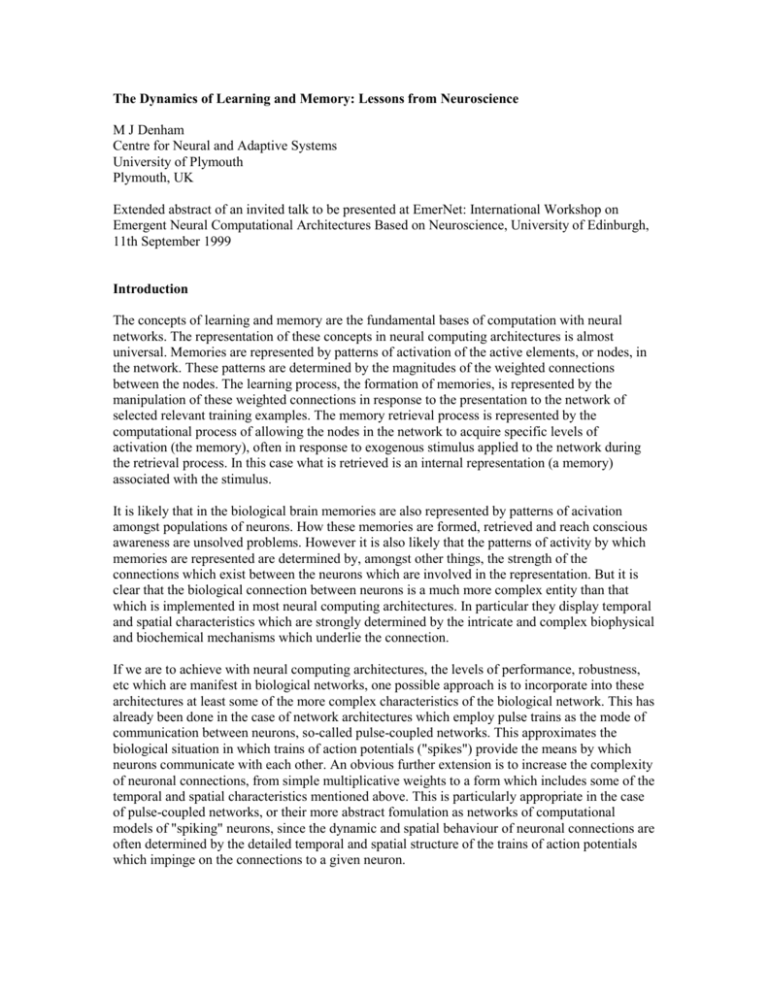
The Dynamics of Learning and Memory: Lessons from Neuroscience M J Denham Centre for Neural and Adaptive Systems University of Plymouth Plymouth, UK Extended abstract of an invited talk to be presented at EmerNet: International Workshop on Emergent Neural Computational Architectures Based on Neuroscience, University of Edinburgh, 11th September 1999 Introduction The concepts of learning and memory are the fundamental bases of computation with neural networks. The representation of these concepts in neural computing architectures is almost universal. Memories are represented by patterns of activation of the active elements, or nodes, in the network. These patterns are determined by the magnitudes of the weighted connections between the nodes. The learning process, the formation of memories, is represented by the manipulation of these weighted connections in response to the presentation to the network of selected relevant training examples. The memory retrieval process is represented by the computational process of allowing the nodes in the network to acquire specific levels of activation (the memory), often in response to exogenous stimulus applied to the network during the retrieval process. In this case what is retrieved is an internal representation (a memory) associated with the stimulus. It is likely that in the biological brain memories are also represented by patterns of acivation amongst populations of neurons. How these memories are formed, retrieved and reach conscious awareness are unsolved problems. However it is also likely that the patterns of activity by which memories are represented are determined by, amongst other things, the strength of the connections which exist between the neurons which are involved in the representation. But it is clear that the biological connection between neurons is a much more complex entity than that which is implemented in most neural computing architectures. In particular they display temporal and spatial characteristics which are strongly determined by the intricate and complex biophysical and biochemical mechanisms which underlie the connection. If we are to achieve with neural computing architectures, the levels of performance, robustness, etc which are manifest in biological networks, one possible approach is to incorporate into these architectures at least some of the more complex characteristics of the biological network. This has already been done in the case of network architectures which employ pulse trains as the mode of communication between neurons, so-called pulse-coupled networks. This approximates the biological situation in which trains of action potentials ("spikes") provide the means by which neurons communicate with each other. An obvious further extension is to increase the complexity of neuronal connections, from simple multiplicative weights to a form which includes some of the temporal and spatial characteristics mentioned above. This is particularly appropriate in the case of pulse-coupled networks, or their more abstract fomulation as networks of computational models of "spiking" neurons, since the dynamic and spatial behaviour of neuronal connections are often determined by the detailed temporal and spatial structure of the trains of action potentials which impinge on the connections to a given neuron. In this talk, I will review the recent knowledge which has been gained in the field of experimental neuroscience concerning the dynamic (both temporal and spatial) characteristics of biological connections between neurons, and their modification under "pairing", the experimental equivalent of Hebbian learning.. I will restrict my remarks to the case of chemical synapses, although it is clear that other connections, eg electrical gap junctions, are also extensive and important in processing in the biological neural network. I will describe briefly some of the computational models of these characteristics which have recently been developed. A greater understanding of how to represent and exploit these biological phenomena computationally could be important for learning how neural computing architectures might achieve the high levels of performance of biological networks. The dynamics of synapses In several experimental studies of the characteristics of synaptic transmission its has been observed that the efficacy of this tranmission can undergo transient variations according to the time history of the activity of the presynaptic neuron . This can either take the form of an shortterm and short timescale increase (facilitation) or decrease (depression) of synaptic efficacy (Thomson and Deuchars, 1994; Markram and Tsodyks, 1996; Abbott et al, 1997; Ali and Thompson, 1998). Synaptic depression has been particularly widely observed in synapses in the developing brain, and may undergo a switch to facilitation in cortical synapses in adult brains (Reyes and Sakmann, 1999). A model of the dynamics of synaptic depression was described recently by Tsodyks and Markram (1997). In fact, this model of the postulated presynaptic dynamics of neurotransmitter release had been proposed previously by Grossberg (1968, 1969) and used subsequently by Grossberg in more recent years, for example to explain a number of important perceptual features involving the visual cortex (see Grossberg, 1998). An alternative form of the model was described recently by Abbott et al (1997). This can be derived from the differential equation form originally proposed by Grossberg (1968, 1969) and later employed by Tsodyks and Markram (1997). Abbott et al (1997) show that their equations can be used to model many aspects of their own experimental data relating to synaptic depression, in particular the sensitivity of the synaptic response to abrupt changes in firing rate of the presynaptic cells. A number of similar models of synaptic facilitation and depression, based on the generic synaptic decoding method of Sen et al (1996), have been discussed recently by Varela et al (1997). The dynamic synapse model characterises the synapse by defining a “resource”, eg the amount of neurotransmitter in the synapse, a proportion of which can be in one of three states: available, effective, inactive. The dynamical behaviour of the proportions of the resource that are in each of these states is determined by a system of three coupled differential equations (1)-(3) below. In these we use notation similar to that in (Grossberg, 1969, see equations (58)-(63)): dx g (t ) y (t ) I (t ) x(t ) dt dy w(t ) g (t ) y (t ) I (t ) dt dw x(t ) w(t ) dt (1) (2) (3) where x(t) is the amount of effective resource, eg activated neurotransmitter within the synaptic cleft, as a proportion of the total resource, y(t) is the amount of available resource, eg free neurotransmitter in the synapse, and w(t) is the amount of inactive resource, eg neurotransmitter being reprocessed. The input signal(t) represents the occurrence of a presynaptic AP and is set equal to one at the time of arrival of the AP and for a small period of time t thereafter, and otherwise is set equal to 0. The instantaneous efficacy of the synapse is determined by the variable g(t), which can be interpreted as the fraction of available resource released as a result of the occurrence of the presynaptic AP. It takes a value in the range zero to one. The key idea behind the model is that there is a fixed amount K = x(t)+y(t)+w(t) of total resource available at the synapse, a proportion g(t) . y(t) (0<g(t)<1) of which is activated in response to presynaptic activity, rapidly becomes inactive (at a rate ), and is then subsequently made available again through reprocessing (at a rate ) . Thus, if the synapse is very active, ie it is bombarded by a large number of presynaptic APs occurring over a short period of time, the amount of available resource y(t) is rapidly reduced. There must then follow a period during which the synapse must recover in order to respond fully once more. This process appears to replicate the experimentally observed characteristics of synaptic depression, for example as reported in (Markram and Tsodyks, 1996; Tsodyks and Markram, 1997). The EPSP at the synapse, e(t), can be computed from the effective synaptic current x(t) in (1) using the following equation for the passive membrane mechanism (Tsodyks and Markram, 1997): EPSP de(t ) x(t ) e(t ) dt (4) Markram and Tsodyks (1996) showed that pairing of the action potential generation in both the pre- and postsynaptic neurons, experimentally equivalent to the condition of Hebbian or associative learning, appears to result in a dynamic change in synaptic efficacy, rather than a simple increase in gain. After pairing, the shape of the EPSP resulting from a high-frequency train of presynaptic APs altered substantially, in that the amplitude of the initial transient part of the EPSP was significantly increased, and the rate of depression of the EPSP to subsequent APs was also greater, whilst the steady state value of the EPSP, on average, remained unchanged, for sufficiently high frequency stimuli (>20 Hz), and increased by up to 70% for low frequency stimuli (<20 Hz). As Markram and Tsodyks (1996) point out, in during most observations of biological neural networks during information processing, neurons are firing irregularly and at a wide range of frequencies. The kind of changes in the dynamics of synaptic connections resulting from Hebbian-type pairing that they observed will therefore result in significant modification of the temporal structure of EPSPs generated by such irregular presynaptic spike trains, rather than that which a simple synaptic gain change would elicit. The dynamics of learning As we have seen, the changes which occur in synaptic efficacy as the result of Hebbian pairing of pre- and postsynaptic activity can substantially alter the dynamic characteristics of the synaptic connection. In addition it has been observed that the induction of long-term changes in synaptic efficacy, ie either long-term potentiation (LTP) or depression (LTD), by such pairing depends strongly on the relative timing of the onset of the EPSP generated by the pre-synaptic AP, and the post-synaptic AP (Levy and Steward, 1983; Debanne et al, 1995; Markram et al, 1997; Debanne et al, 1998; Guo-quiang Bi and Mu-ming Poo, 1998). The precise cellular mechanisms which are responsible for the induction of LTP and LTD are not known. However the process seems to involve the initiation in the neuron's axon of an AP which actively and rapidly propagates back into the dendritic tree of the cell. The pairing of this AP with a subthreshold EPSP results in a amplification of the dendritic AP and a localised influx of Ca2+ near the site of the synaptic input. This also induces significant LTP of the synapse and corresponding increases in the average amplitude of unitary EPSPs (Magee and Johnston, 1997) Back-propagating APs reduce in amplitude with their distance from the cell body, although pairing with synaptic activity increases AP amplitude, and this increase is greater with increasing distance of the synapse from the cell body. APs are also attenuated or their back-propagation blocked by dendritic hyperpolarisation. Thus the occurence of synaptic input to the dendritic tree can have the effect of closely controlling the back-propagation of the APs to more distal parts of the tree, thus introducing a complex spatio-temporal dynamics into the synaptic modification process. In particular, synapses are only modified in those parts of the tree which backpropagating APs are allowed to access, which depends on the precise timing and location of EPSPs and IPSPs at the inputs to the tree, relative to the APs. Markram et al (1997) are amongst the most recent researchers (others are cited above) to observe that this relative timing of EPSPs and APs can either result in LTP or LTD of the synapse. The former occurs if the onset of the EPSP occurs around 10 ms before the AP then LTP is induced; if the AP preceeds the onset of the EPSP by the same amount of time, LTD occurs. Relative timings of 100 ms either way resulted in no change to the synaptic strength. Several authors have suggested different forms of simple Hebbian learning rule which attempt to capture computationally this temporal asymmetry (Grossberg, 1969; Senn et al,1997; Denham and Denham, 1998; Kempter et al, 1999). Most recently Migliore et al (1999) have captured this effect, together with the modulation of the amplitude of the back-propagating AP, in a computational model of a hippocampal CA1 pyramidal neuron, modelled using a total of 202 compartments for the cell's axon., soma and dendrites. They show how the modulation and timing effects may depend on the properties of a transient K+ conductance that is strongly expressed in hippocampal dendrites. Conclusion In the biological neural network, synaptic connections and their modification by Hebbian forms of associative learning have been shown in recent years to have quite complex dynamic characteristics. As yet, these dynamic forms of connection and learning have had little impact on the design of computational neural architectures (eg Gerstner, 1998). It is clear however that for the processing of various forms of information, in which the temporal nature of the data is important, eg in temporal sequence learning and in contextual learning, such dynamic characteristics may play an important role. Much work is required in order to fully explore this possibility. It is only one of many lessons which can be drawn from neuroscience which can informus about how the biological neural network achieves its remarkable robustness and efficiency. References Abbott, L.F., Varela, J.A., Sen, K. & Nelson, S.B. (1997). Synaptic depression and cortical gain control. Science, 275, 220-224. Ali AB, Thompson AM (1998) Facilitating pyramid to horizontal oriens-alveus interneurone inputs: dual intracellular recordings in slices of rat hippocampus. Journal of Physiology (London) 507, 185-199. Debanne, D., Shulz, D.E., & Fregnac, Y. (1995). Temporal constraints in associative synaptic plasticity in hippocampus and neocortex. Canadian Journal of Physiological Pharmacology, 73, 1295-1311. Debanne, D., Gahwiler, B.H. & Thompson, S.M. (1998). Long-term synaptic plasticity between pairs of individual CA3 pyramidal cells in rat hippocampal slice cultures. Journal of Physiology (London), 507.1, 237-247. Denham MJ, Denham SL (1998) A dynamic learning rule for synaptic modification. Proceedings of the 2nd CNS Conference, Dept of Cognitive and Neural Systems, Boston University, May 1998 (abstract only). Fitzsimonds, R.M., & Mu-Ming Poo. (1998). Retrograde signaling in the development and modification of synapses. Physiological Reviews, 78, 143-170. Gerstner, W. (1998). Spiking neurons. In: W. Maass and C.M. Bishop (eds), Pulsed Neural Networks (pp. 3-54) , Cambridge: MIT Press. Grossberg, S. (1968). Some physiological and biochemical consequences of psychological postulates. Proceedings of the National Academy of Science USA, 60, 758-765. Grossberg, S. (1969). On the production and release of chemical transmitters and related topics in cellular control. Journal of Theoretical Biology, 22, 325-364. Grossberg, S. (1998). Birth of a learning law. INNS/ENNS/JNNS Newsletter, 21, 1-4. Appearing with Neural Networks, 11, 1. (Preliminary version published as Technical Report CAS/CNS-TR97-017, Centre for Adaptive Systems, Boston University.) Guo-qiang Bi & Mu-ming Poo (1998). Synaptic modifications in cultured hippocampal neurons: dependence on spike timing, synaptic strength, and postsynaptic cell type. Journal of Neuroscience, 18, 10464-10472. Kempter, R., Gerstner, W., & van Hemmen, J.L. (1999). Spike-Based Compared to Rate-Based Hebbian Learning. In: Advances in Neural Information Processing Systems 11, Cambridge: MIT Press (to appear). Levy, W.B. & Steward, O. (1983). Temporal contiguity requirements for long-term associative potentiation/depression in the hippocampus. Neuroscience, 8, 791-797. Magee, J.C. & Johnston, D. (1997). A synaptically controlled associative signal for Hebbian plasticity in hippocampal neurons. Science, 275, 209-212. Markram, H., Lubke, J., Frotscher, M. & Sakmann, B. (1997). Regulation of synaptic efficacy by coincidence of postsynaptic APs and EPSPs. Science, 275, 213-215. Markram, H. & Tsodyks, M. (1996). Redistribution of synaptic efficacy between neocortical pyramidal neurons. Nature, 382, 807-810. Migliore M, Hoffman DA, Magee JC, Johnston D (1999) Role of an A-type K+ conductance in the back-propagation of action potentials in the dendrites of hippocampal pyramidal neurons. Journal of Computational Neuroscience, 7, 5-15. Reyes A, Sakmann B (1999) Developmental switch in the short-term modification of unitary EPSPs evoked in layer 2/3 and layer 5 pyramidal neurons of rat neocortex. Journal of Neuroscience 19, 3827-3835. Sen, K., Jorge-Rivera, J.C., Marder, E., & Abbott, L.F. (1996). Decoding synapses. Journal of Neuroscience, 16, 6307-6318. Senn, W., Tsodyks, M., & Markram, H. (1997) An algorithm for synaptic modification based on exact timing of pre- and post-synaptic action potentials. In Lecture Notes in Computer Science Vol. 1327 (pp 121-126) , Springer. Thompson AM, Deuchars J (1994) Temporal and spatial properties of local circuits in neocortex. Trends in Neuroscience, 17, 119-126. Tsodyks, M.V., & Markram, H. (1997) The neural code between neocortical pyramidal neurons depends on neurotransmitter release probability. Proceedings of the National Academy of Science USA, 94, 719-723. Varela, J.A., Sen, K., Gibson, J., Fost, J., Abbott, L.F., & Nelson, S.B. (1997) A quantitative description of short-term plasticity at excitatory synapses in layer 2/3 of rat primary visual cortex. Journal of Neuroscience, 17, 7926-7940.

